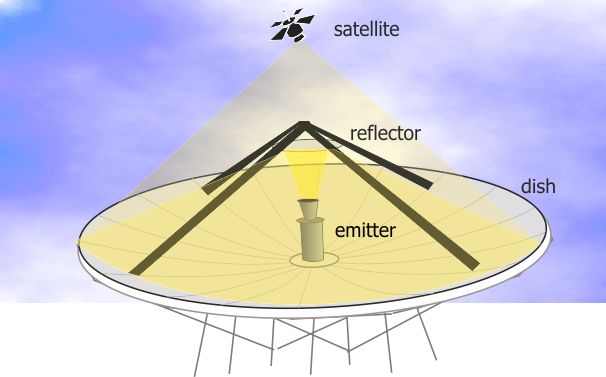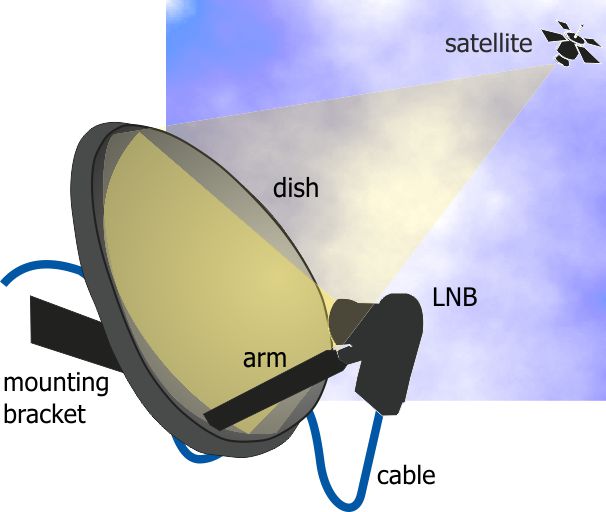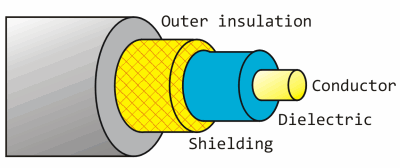Freesat reception - all about dishes
 Brian Butterworth published on UK Free TV
Brian Butterworth published on UK Free TV Satellite reception has both advantages and disadvantages compare with terrestrial (aerial) reception.
By using much higher frequencies (gigahertz, compared to terrestrial televisions megahertz) more transmission channels called transponders (the satellite equivalent of multiplexes) can be provided. For example, there are only six Freeview multiplexes, but Sky or Freesat users can access two hundred satellite transponders.
Aside from exceptional weather conditions (very heavy rain for example) digital satellite provides stable pictures and audio. Where Freeview transmitters are no more than 732 metres above sea level, the geostationary satellites used for television are 35,800,000 metres above the equator so reception is possible even where buildings, trees and hills make terrestrial reception impossible.

The downside of the transmitters being 22,300 miles up in the air is that the signals are very, very weak - so standard TV aerial is of little use. When the signals are sent to the satellites, huge dish transmitters are used to uplink the signal to the satellite. These are tens of metres from side to side, and feature an emitter that generates the signal, which is first bounced of a mirror (called a reflector) and then off the surface of the parabolic dish.

There are many satellites in the sky over the equator. Often these are in clusters over a particular position, for example there are four used for UK television are at 28.2 degrees east. There is another cluster over the 19.2 degrees east positions that are used for German television.
To receive these very weak signals from the satellite, it is necessary to use a dish for reception too. By using a reflective dish, this concentrates the signals onto a small device called a LNB. This is held in front of the dish by a metal arm.

The size of dish for reception is typically much smaller; often 60cm to 100cm in diameter, but the exact size depends upon the transmitting satellite transponder. To keep the transmission power levels down to levels that can be powered by the satellite's solar panels, each beam is focused on a particular area of the Earth's surface. If you are trying to receive the signal at the centre of this zone, a small dish is required. At the outer edges, you may need a 5 metre dish. Maps of these zones are provided by the satellite companies, and are called satellite footprints.
When the dish is installed it must be aligned carefully as the signal is very weak. The installer needs to know the inclination and the azimuth from the ground location to the satellite. If you install yourself you will find that there are markings on the dish that are used to point the dish in the correct position. It is important that the view of the satellite will not be blocked, so must take into account leaves growing on trees and potential building works.
For many people the LNB will have a single cable connected to it, however if you have Sky+ or a multi-room installation the LNB package will actually contain four receivers a quad-LNB. Unlike terrestrial television where you can split the aerial cable to feed more than one Freeview box or television set, with satelite reception you cannot. So, a Sky+ box with two receivers (so you can watch one thing and record another) has two cables connecting the box to the dish.
The cable that connects the dish to the receiver must be satellite grade cable. Whilst this looks superficially like the cable used to connect and aerial to a television, a higher grade cable is required for satellite reception.
Here is an image of a co-axial cable. This sort of cable is used to connect any type of receiving aerial to the reception equipment.

RG6, PF100 and PH100 are all types of coax cable that are suitable for the very weak signals that are received by a satellite dish. (The power is the same as you would receive from a one-bar electric heater on the moon).
The conductor in the centre passes the signals received from the dish to the set-top box. This is made from steel in RG6 cable, and from copper in the RF100 and PH100 types. This makes RG6 less suitable in the UK where rain can damage the cable.
The shielding is responsible for keeping unwanted external interference from damaging the signal. In the cheaper cable this will be a foil wrap, in better specified cables this is a braid (or mesh) of copper wires. The sheild in the RF100 covers 58% of the cable.
The non-conducting layer between the shield and the conductor is called the dielectric. This can be either a solid (RG6), foam (RF100) or air-spaced (PH100) dielectric. This makes the cables progressively more flexible (ie bendy without damage).
Lisa2806: You can't pick up Freeview in Germany, it is only broadcast from terrestrial transmitters in the UK.
Your communal dish will not be pointing at the correct satellites to use FreeSAT.
| link to this comment |
8:38 PM
hi all i have benn toying with the idea of replacing my sky minidish with an 80 cm motorised dish can someone advise me if i will be able to use my sky hd box and a secondary box to be specific a konig sdfta11 what lnb will i need and also can the sdfta11 be set up to move the dish cheers
| link to this comment |
peter clark: Sky+HD boxes are not really suitable for use in this respect. It would be better to fit your motorised dish as a second dish and use another receiver with it.
| link to this comment |
10:00 AM
Briantist ok cheers mate i 'll have to ask for permission to fit a second dish as i am a council tennant it does sound easier cheers again
| link to this comment |
11:04 AM
Sheffield
Is there a good channel guide to FREESAT which includes BBC regions and nations, and ITV regions? Friend having Freesat insrtalled soon but wants to play around with it.
| link to this comment |
Steve's: mapS's Freeview map terrainS's terrain plot wavesS's frequency data S's Freeview Detailed Coverage
12:07 PM
Steve - "Freesat" has it's own EPG (Electronic Programming Guide). Normally at "Setup" you would enter your UK postcode so that once the receiver scans it will default to your local ITV/BBC region - (although you can choose to set an alternative ie: any UK postcode). Whichever postcode you opt for all regional BBC/ITV channels are scanned in and therefore are available through pressing the "List" or "Guide" options using the remote.
Dependent on the receiver chosen a non "Freesat" mode is accessible where all available FTA (Free to Air) channels become available including those not listed on the "Freesat" EPG.
Additionally Humax (excepting the 500GB DTR version) and Technisat receivers offer diseqc multisat options.
| link to this comment |
9:28 PM
hi brian we had free view fitted and a satelite dish we have now bought over our sky box but when we plug it in it says adjust your signal can we do this our self our can you recommend some one in arcos de la frontera spain many thanks.
| link to this comment |
1:49 PM
Hi
I have Freesat HD+ in my Living Room and love it - I said goodbye to Sky a couplf of years ago.
To have an output in my kitchen, I currently use a universal modulator to link up through the coax cable to my kitchen (the quality is okay for the small telly but wouldn't be good enough for a large one).
I'm about to extend my kitchen and knock through to my dining room to make one large room.
I have a couple of questions - hope you can help
1. For the new room can I just buy another freesat HD+ box and add 2 more cables to my old sky dish or do I need to upgrade the receiver on the dish.
2. If I want to have 2 tvs at either end of the new room to watch the same program, is the best way to connect them by running a c.10 metre HDMI cable between them?
3. Is there anyway to
| link to this comment |
1:52 PM
Oops - posted it before I finished writing - here is the full question.
Hi
I have Freesat HD+ in my Living Room and love it - I said goodbye to Sky a couplf of years ago.
To have an output in my kitchen, I currently use a universal modulator to link up through the coax cable to my kitchen (the quality is okay for the small telly but wouldn't be good enough for a large one).
I'm about to extend my kitchen and knock through to my dining room to make one large room.
I have a couple of questions - hope you can help
1. For the new room can I just buy another freesat HD+ box and add 2 more cables to my old sky dish or do I need to upgrade the receiver on the dish.
2. If I want to have 2 tvs at either end of the new room to watch the same program, is the best way to connect them by running a c.10 metre HDMI cable between them?
3. Is there anyway to get the 2 PVRs to talk to each other or do you just need to record the same programme on both sets?
Many thanks in advance,
Henry
| link to this comment |
6:38 PM
Henry,the best option is to have an additional feed(s) taken from the Dish LNB to the new receiver. Your current LNB is likely to have a four output capacity so there should be two of these unused where connections can be made.
Tip:- Make sure that the protective strip under the front flap is removed on your current receiver and on any additional receiver. Some have found problems with what was thought the Hunax DTR remote control - not so - Simply pick the edge back with your finger nail and the strip will peel back.
| link to this comment |